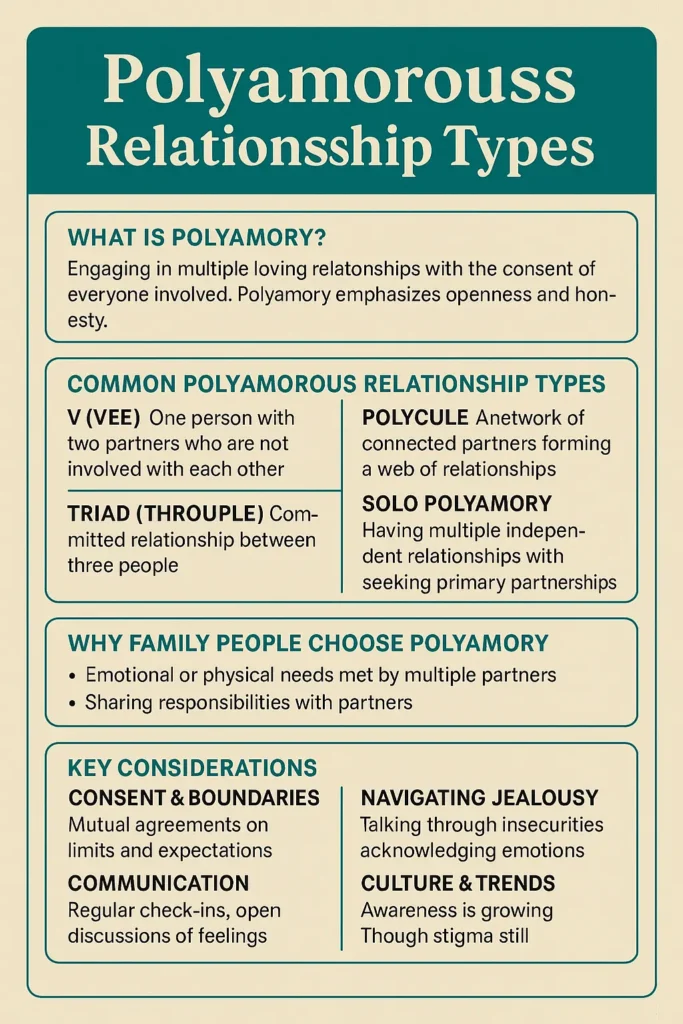Polyamory, at its heart, means “many loves.” It describes the practice of having multiple loving, consensual relationships at the same time. Increasingly, many people in the U.S. are learning that love and commitment can take different forms beyond the traditional one-partner model. Instead of an exclusive partnership model, polyamorous people build networks of relationships with the knowledge and consent of everyone involved. For many, polyamory means realizing that one person doesn’t have to be “everything” – multiple loving relationships can bring more happiness and support. Unlike cheating or secret affairs, polyamory is based on openness and honesty.
Defining Polyamorous Relationships
Polyamory is one form of ethical non-monogamy, which means any relationship where everyone agrees to the arrangement. According to Psychology Today, consensual non-monogamy is “the practice of engaging in multiple romantic, sexual, and/or intimate relationships with partners who are all consenting to that arrangement”. In other words, it’s about creating relationships that work for the people involved, outside traditional monogamous norms. Polyamory differs from polygamy (which involves multiple legal marriages in certain cultures) and from infidelity, because everyone involved knows about and consents to the situation.

Common Polyamorous Relationship Structures
In practice, polyamorous relationships can take many forms. One way to categorize them is by how the relationships are arranged and prioritized. For example, in a “V” (vee) structure, one person (the “hinge”) is in relationships with two others who are not romantically involved with each other. The two partners who share the hinge are called metamours to each other. If all three people are involved with one another, that group is called a triad or “throuple.”
In many cases, people describe their entire network of partners as a polycule. This term, a blend of “polyamory” and “molecule,” refers to the group of all people in a polyamorous relationship network. For example, one person might have two partners, each of whom might have other partners. Those connections form a web of relationships – a polycule like the one illustrated above. Each line in the diagram represents a romantic or intimate connection, and everyone in that web is part of the same relationship system.
Within any polycule, individuals may prioritize relationships differently. Hierarchical polyamory means one relationship is given more priority than the others. Someone might have a “primary” partner they live with or share finances with, plus additional “secondary” or “tertiary” partners who take a backseat in time and decision-making. By contrast, non-hierarchical polyamory treats all partners more equally. In that approach, even if time and resources are limited, partners try to avoid ranking one relationship over another – decisions are made with everyone in mind.
Another approach is solo polyamory, where a person maintains multiple meaningful relationships but chooses to stay independent. A solo polyamorist may date several people without seeking to marry or live with any one partner. They value personal autonomy and often prefer that each partner has their own household and life. Some people pursue solo polyamory during certain seasons (for example, focusing on a career or personal goals), while others identify as solo polyamorists as an ongoing lifestyle choice.
Key Terms
- Polycule: The network or “family tree” of people connected by polyamorous relationships.
- Metamour: Your partner’s partner – someone you are connected to indirectly through a shared lover.
- Throuple (Triad): A committed relationship of three people.
- Primary/Secondary: In hierarchical polyamory, “primary” denotes the most prioritized partner, while “secondary” or “tertiary” denote others who may have less priority.
- Polygamy vs. Polyamory: Polygamy is the practice of having multiple spouses (often in certain religious or cultural contexts), whereas polyamory is about multiple loving relationships without necessarily marrying.
- Open Relationship: A term for partnerships where one or both people agree to date or have sex outside the core relationship; polyamory can include open relationships if multiple deep partnerships are formed.
Why People Choose Polyamory
Many polyamorous people say they feel happier when they can share love with more than one person. With multiple partners, an individual may find that different emotional or physical needs are met by different people. For example, one partner might be a great listener and comforter, while another is adventurous and spontaneous. Having multiple connections can mean more emotional support and shared responsibilities in life. As one author explains, in polyamory “you can have unlimited love, but you do not have unlimited time”. This means each person learns to prioritize time and energy carefully, making choices about how to share their life and love with others.
As with any relationship style, polyamory comes with challenges. Communication is especially important: polyamorous partners often schedule regular check-ins to talk about feelings, boundaries, and expectations. For example, therapist Sarah Stuteville emphasizes starting with “honest and clear communication” and setting aside time to discuss what’s working and what isn’t. Jealousy can arise, but many polyamorous people find that talking through insecurities and acknowledging emotions openly can actually strengthen trust. Support groups, books, and experienced community members can help couples navigate the ups and downs of polyamory and learn best practices.
Navigating Consent and Boundaries
Since polyamory often involves multiple partners, establishing boundaries is crucial. Some relationships might have rules about safer sex practices, time spent alone with each partner, or how much to share about other relationships. Each group of partners negotiates these rules differently, based on what feels right for them. For instance, some people prefer “kitchen table” polyamory where everyone in the polycule knows and gets along with each other, while others are more private. Because polyamorists reject a one-size-fits-all script, each set of partners often co-creates its own agreements. The key is mutual consent: every person affected by a new relationship should be part of the conversation. Psychology Today notes that polyamory is about “co-creating relationships that work for the people involved” – which means defining your own expectations, commitments, and level of closeness.
Culture and Trends
Polyamory remains a minority practice, but awareness is growing. Surveys indicate that many Americans are curious about or open to non-monogamy. According to a 2023 poll by YouGov, 34% of U.S. adults say their ideal relationship is something other than completely monogamous. Younger people tend to be more open to this idea, and acceptance is increasing in LGBTQ+ communities as well. Media representation of polyamory – from TV shows to news stories – also helps demystify it for a broader audience. Still, stigma can remain, and polyamorous people often emphasize the importance of educating friends and family, so that their lifestyle is respected.
Conclusion
The landscape of polyamorous relationships is diverse. It can range from a couple who agree to include others, to group arrangements of three or more, to individuals sustaining multiple partnerships on equal footing. What these forms share is informed consent, clear communication, and a commitment to honesty. As society becomes more open to different ways of loving, resources and support for polyamory are increasing. According to experts, polyamory challenges traditional relationship scripts and offers an alternative framework for love and connection. For anyone exploring polyamory, clear communication and understanding personal needs are key. By learning about consent and boundaries, individuals can create healthy polyamorous connections that truly fit their lives.
FAQs
What is polyamory?
Polyamory means having multiple romantic partners at the same time, with everyone’s informed consent. It emphasizes honesty and communication, so that all partners know about and agree to the relationships.
What are common polyamorous relationship types?
There’s no fixed list, but common forms include hierarchical (one primary partner plus others), non-hierarchical (partners share equal status), solo polyamory (someone has many partners but stays independent), and relationship anarchy (no labels or rank at all). There are also V-structures (one person with two partners who don’t date each other), triads (three people all involved with each other), and quads (four-person relationships).
How do hierarchy and non-hierarchy differ?
In hierarchical polyamory, one partner (the primary) might be prioritized for things like living together or family decisions, and secondary partners have lower priority. Non-hierarchical polyamory avoids ranking partners; everyone is treated more equally, and decisions are made with all partners in mind.
What is solo polyamory?
Solo polyamory means having multiple serious partners while maintaining independence. A solo polyamorist typically doesn’t live with or marry any one person; they keep their own household and life plans. This style values personal freedom while still enjoying loving relationships.
What is relationship anarchy?
Relationship anarchy is a philosophy where all relationships are considered equally important and rules or hierarchies are rejected. People practicing it make decisions about each relationship uniquely, rather than following cultural expectations. It’s about co-creating relationships on your own terms.
How can polyamorous relationships handle jealousy?
Jealousy is natural and can happen in any relationship. Polyamorous people usually handle it by talking openly. If someone feels jealous, they discuss it with partners to find understanding. Many find that being honest about feelings and recognizing jealousy as a signal can help strengthen trust.
Is polyamory legal in the U.S.?
Simply having multiple consenting partners is not illegal; adults can agree to any relationship structure. However, multiple marriage (polygamy) is illegal in the United States. Polyamorous families might face challenges with things like custody or insurance, but there’s no law banning polyamory itself.
How common is polyamory?
Estimates vary, but research suggests at least a few percent of people practice polyamory. For example, research reported on Phys.org notes that around 4–5% of Americans are in consensual non-monogamous relationships. Surveys show many more people say they are open to non-monogamy or have tried it at some point.
What is a polycule or metamour?
A polycule is the network or map of all the partners in a polyamorous arrangement. A metamour is your partner’s partner – someone you’re connected to through a mutual lover. For example, if Alice is with Bob and Bob is also with Carol, then Alice and Carol are metamours of each other.
How do polyamorous couples make time for everyone?
Managing multiple relationships takes coordination. Many use tools like shared calendars or scheduling apps. They often talk openly about how much time each partner needs and plan dates or group time. By staying organized and flexible, they find ways to make sure each person feels valued and included.

1 thought on “Polyamorous Relationship Types: Love’s Many Forms”